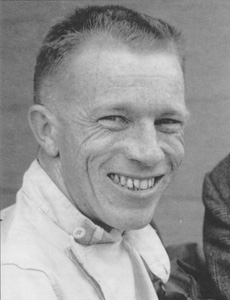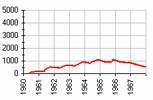Гонщики, G | |
Ginther, Richie Курсивом отмечены гонщики, |
| Ричи ГинтерGinther, RichieGinther, Paul Richard |
 (c) 'Who is Who' by Steve Small, 2000 Родился: 05.08.1930 Голливуд, Калифорния Умер: 20.09.1989 Тузак-ле-Руку, Бордо, Франция Сезонов в Ф1: Лет в Ф1: 8 Гран При: Старты: 52* *не стартовал: 3 Победы: - подряд: Подиумы: - подряд: 4 Поул-позиции: - подряд: Первый ряд: - подряд: 2 Быстрые круги: - подряд: Лучший финиш: Лучший старт: 2 Дубли: Хет-трики: Лидирование старт/финиш: Большие шлемы: Круги: - лидирования: 92 Километры: - лидирования: |
Год | Команда | Шасси |
Small and freckle-faced, Richie Ginther was always just outside the top echelon of Grand Prix talent but on his day he was more than capable of delivering the goods. In many ways he was the perfect number two driver, being conscientious, reliable and an extremely fine tester, with a rare mechanical sympathy born of his early days as a mechanic on both cars and aeroplanes during his National Service.
Although he had run an MG in 1951, it was two years later that he really became involved in serious competition when he shared Phil Hill's Ferrari in the Carrera Panamericana. The pair were lucky to emerge unscathed from a crash which wrote off the car, but returned the following year to take second place behind Maglioli's works entry.
Richie then found employment with Ferrari importer Johnnie von Neumann, who gave him plenty of drives over the next few seasons, Ginther making a big name for himself in West Coast racing and coming to the attention of Luigi Chinetti, who in turn entered him in his Ferraris, Richie's programme including a visit to Le Mans in 1957. Combining his job running the car agency with a racing career was becoming something of a strain, but after he shared a Ferrari sports car with von Trips to take second place in the Buenos Aires 1000 Km, Ginther was offered a four-race contract by the Scuderia. He quit his job and took the opportunity, moving to Italy with his wife. Although the sports car races yielded no success, his single-seater rides were a revelation. He was second in the Modena GP in the front-engined F2 car and made three Grand Prix starts, finishing an impressive sixth at Monaco in the rear-engined prototype, and second at Monza in the boycotted Italian GP. Quickly realising his tremendous engineering expertise, Ferrari gave Richie the role of chief development driver in addition to his racing duties. In 1961 the team virtually swept the board with their 'sharknose' 156 V6 car and Ginther really impressed with his spirited pursuit of Stirling Moss at Monaco. Surprisingly he found himself surplus to requirements at the end of the year but BRM were more than willing to bring him into the fold.
He made an ideal partner to Graham Hill, putting in much hard work as the Bourne team came good at last and won the World Championship. The 1963 season was his most successful and consistent, Ginther scoring points in every Grand Prix bar one to finish equal second with his team-mate in the championship behind runaway winner Jim Clark. Ginther stayed on for a third year in 1964, again proving his mechanical sympathy by finishing every Grand Prix.
It was all-change for 1965 as Ginther was hired to bring some much-needed experience to the still-fledgling Honda project. As the season wore on the car became a real threat, until Richie had his greatest moment when he won the Mexican Grand Prix at the last race of the year. It must have been galling for all concerned that it marked the end of the 1.5-litre formula, for Honda would have been a very tough act to beat in 1966 under the old rules. As it was they had to start again, and after filling in with a Cooper until the new car was ready towards the end of the season, Ginther was fortunate to escape a huge accident at Monza when a tyre failed. For 1967 Honda went with John Surtees and Richie joined up with Dan Gurney at Eagle. He lay second in the Race of Champions before retiring, but then surprisingly failed to qualify at Monaco. While practising for the Indianapolis 500 he suddenly decided that it was time to quit. Richie became involved in team management roles, for example running a Porsche 911 with Elliot Forbes-Robinson in 1971, before cutting his links with the sport and dropping out of the rat race to live in a camper in the desert. He returned to the circuits in 1977, invited to the German GP at Hockenheim by Goodyear to present the winner, Niki Lauda, with a prize to mark the tyre company's 100th win, though many would not have recognised him with his moustache and long hair replacing the once familiar crew-cut.
It was a frail and sick Ginther who arrived at Donington in 1989 to attend BRM's 40th anniversary celebrations, and it was with much sadness but little surprise that the racing world learned of his death after a heart attack just days later while holidaying in France.
(c) 'Who is Who' by Steve Small, 2000
| © WildSoft, 1995-2020 |


